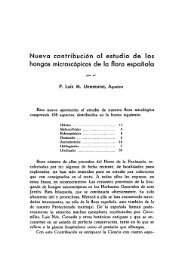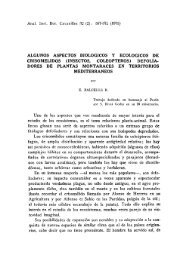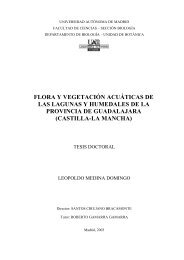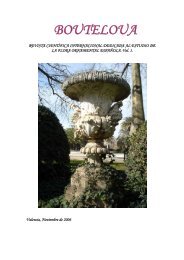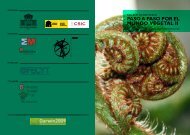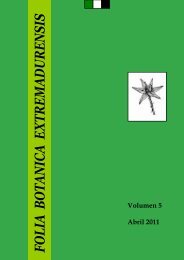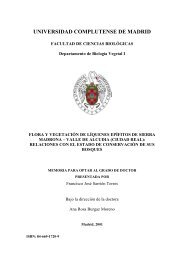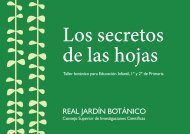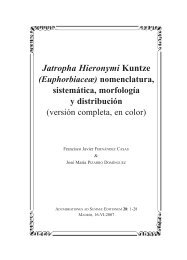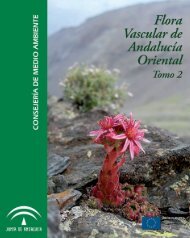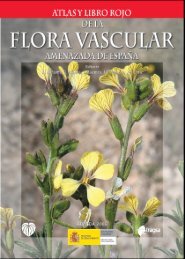el genero luzula en españa - Real Jardín Botánico - Consejo ...
el genero luzula en españa - Real Jardín Botánico - Consejo ...
el genero luzula en españa - Real Jardín Botánico - Consejo ...
You also want an ePaper? Increase the reach of your titles
YUMPU automatically turns print PDFs into web optimized ePapers that Google loves.
522 ANALES DEL INSTITUTO BOTÁNICO A. J. CAVANILLES<br />
que repres<strong>en</strong>ta los detalles morfológicos más importantes para difer<strong>en</strong>ciar<br />
las estirpes que reconoció <strong>en</strong> España.<br />
Basa su estudio corológico <strong>en</strong> datos de herbario, completándolo con<br />
los aportados por las publicaciones. Completa este aspecto con unos<br />
mapas de distribución que dan una idea aproximada d<strong>el</strong> área de cada<br />
estirpe.<br />
ENGLISH SUMMARY<br />
The g<strong>en</strong>us Lumia in Spain<br />
This is a revisión of Spanish material of Luzula collected by the author and,<br />
in addition, of the Spanish specim<strong>en</strong>s oí this g<strong>en</strong>us in the herbaria of Madrid (M)<br />
and Barc<strong>el</strong>ona (BC and BCF). Iavestígation of intraspecific variation has led to<br />
the description of some sew taxa after the examination of abundant material subjected<br />
to biometric studies.<br />
The great variability of L. forsteri, L. silvatica, L. nutans, L. caespitosa, L. campestris,<br />
L. sudetica and L. multiflora is interesting. In the Pyr<strong>en</strong>ees L. lutea differs<br />
from the typical plant of the Alps, and the author proposes its recognition as ssp.<br />
pyr<strong>en</strong>aica.<br />
Chorology and new taxonomic characters (see the figures) are based on rec<strong>en</strong>tly<br />
collected material. L. pallesc<strong>en</strong>s and L. luzulina are new for the flora of Spain.<br />
A demonstration is giv<strong>en</strong> of the possibilities of palynological studies in investigating<br />
the geographical variaríon within species. The author has also cornpiled<br />
a list of bibliographical refer<strong>en</strong>ces to cytological data, which should be of<br />
use to workers on caryosystematics who need to study caryotypes of individuáis<br />
from natural populations. With this in view, he has paid special att<strong>en</strong>tion to the<br />
microtaxonomy of this g<strong>en</strong>us.<br />
The paper is based on classical taxonomy, with a bias in the direction of the<br />
new systematics and the study of variation within and betwe<strong>en</strong> populations. The<br />
author hopes that it will be useful for taxonomists and cytologists, and also<br />
for plant collectors in Spain.<br />
NOTAS FINALES. — Terminado este trabajo, antes de su aparición definitiva,<br />
he recibido la interesante publicación de S. RIVAS-MARTÍNEZ, 1963, «Estudio<br />
de la vegetación y flora de bis sierras de Guadarrama y Gredos». An. I. Bot.<br />
A. J. Cavan. 21 (1) : 1-32S. Madrid. En las páginas 287-289 cita varias Luzula<br />
y describe algunas novedades, con refer<strong>en</strong>cia al pres<strong>en</strong>te trabajo, que pudo consultar<br />
cuando permanecía inédito.<br />
L. spicata (L.) DC. no parece corresponder a la ssp. mutabilis de los Cárpatos;<br />
no es probable que sea ssp. spióata, pero es prematuro asignarle «status»<br />
definitivo.



